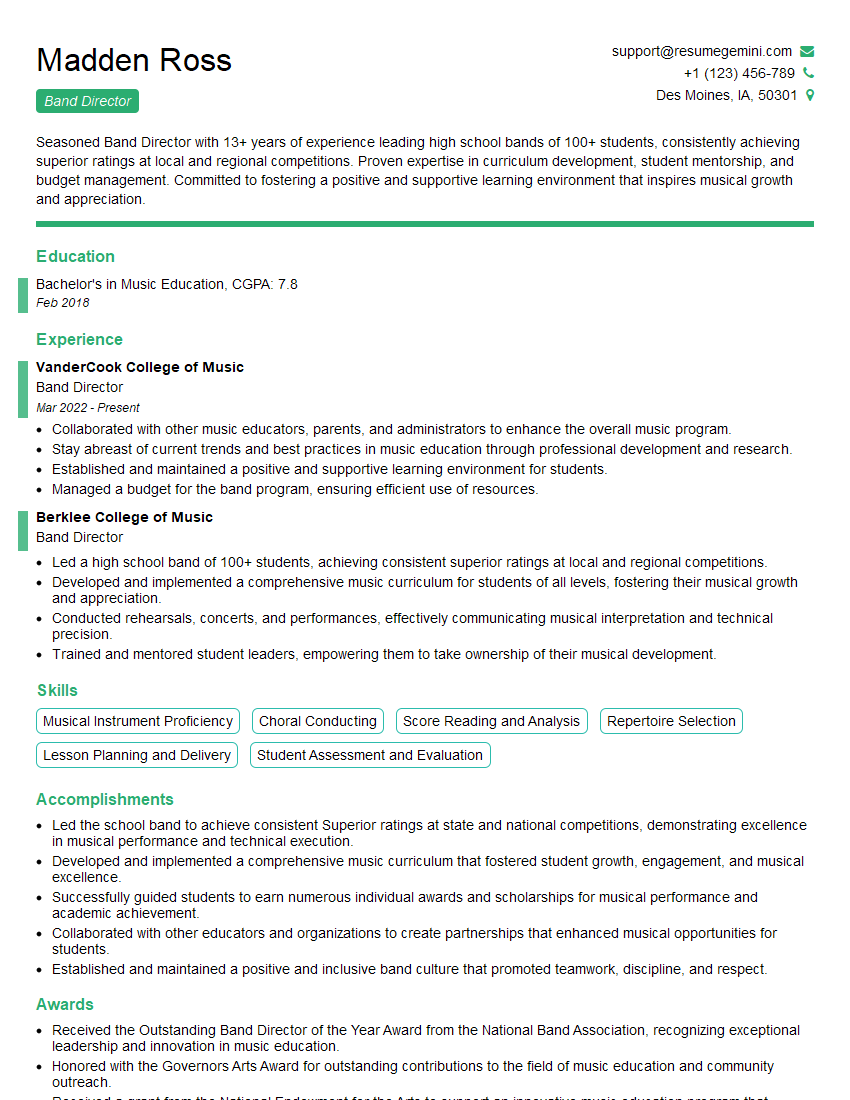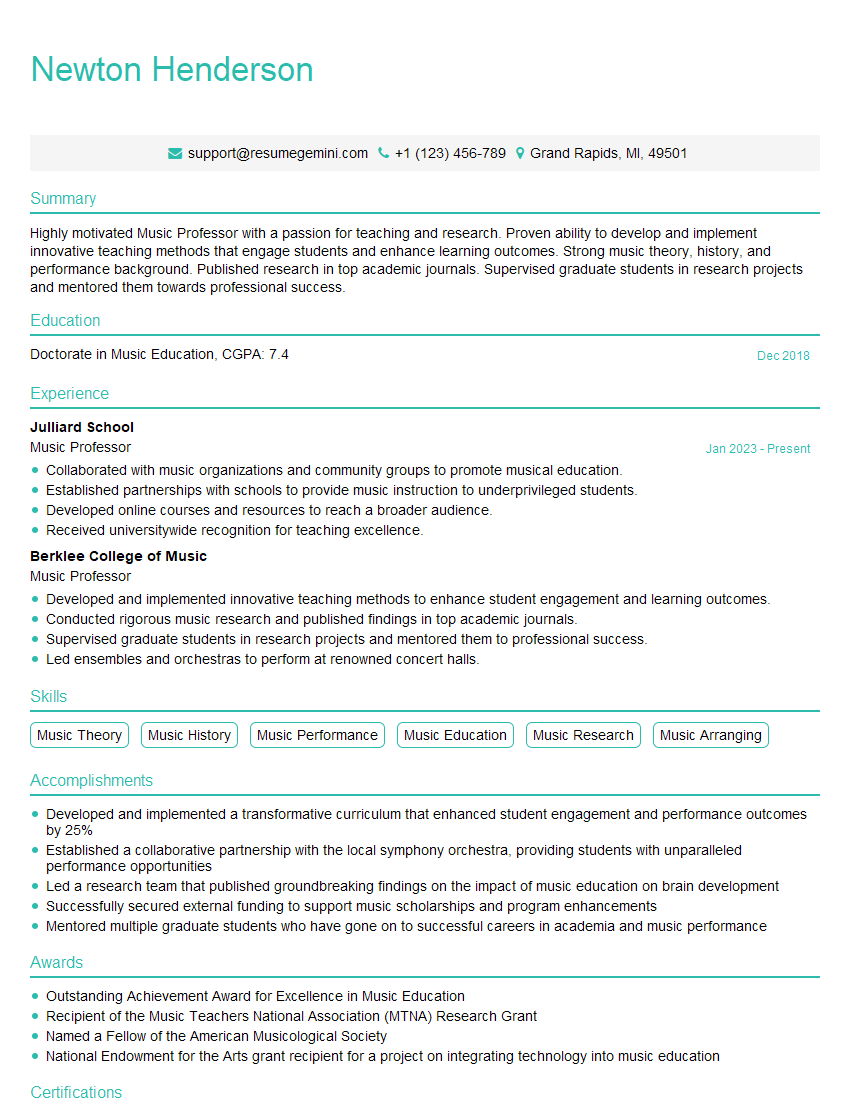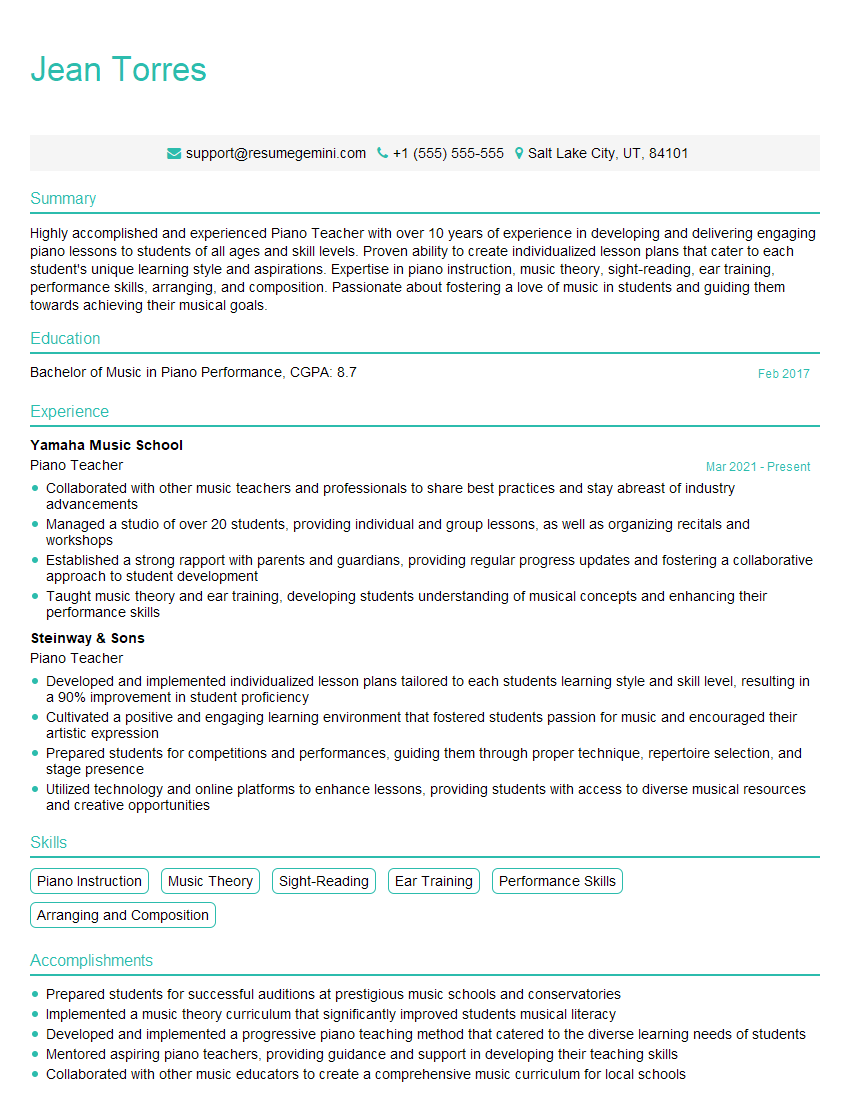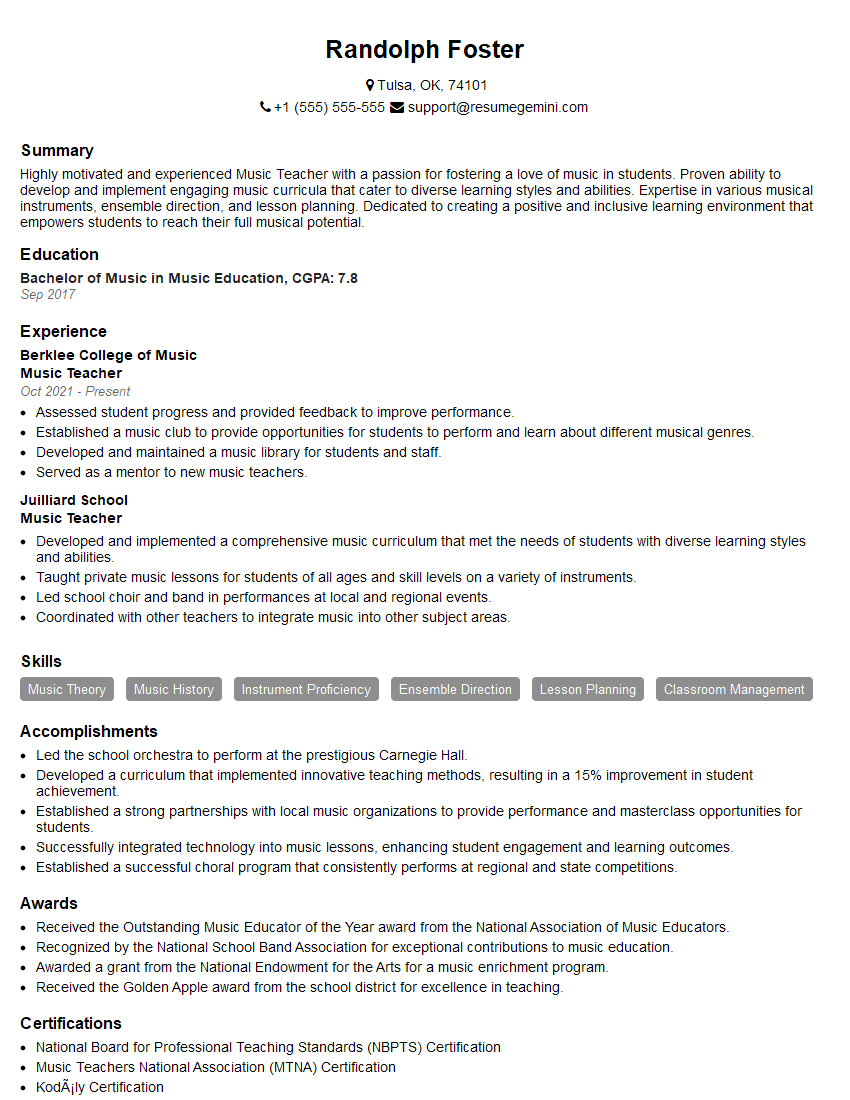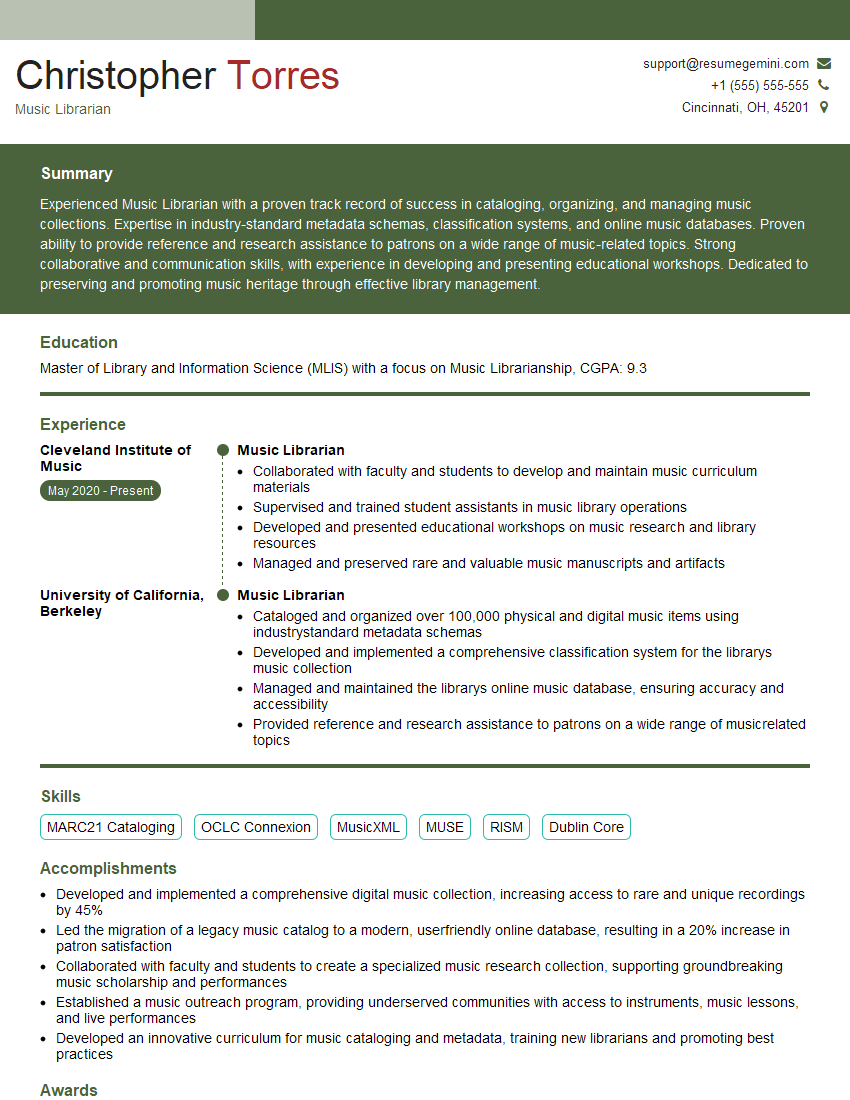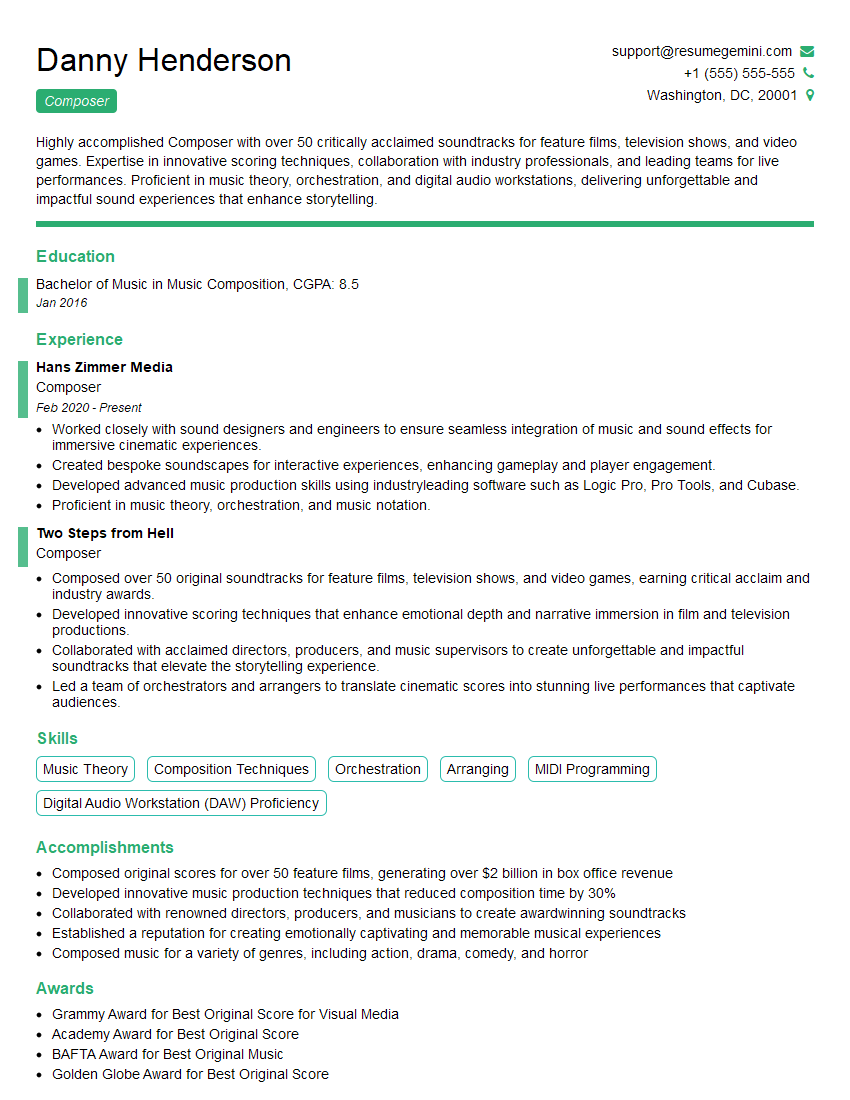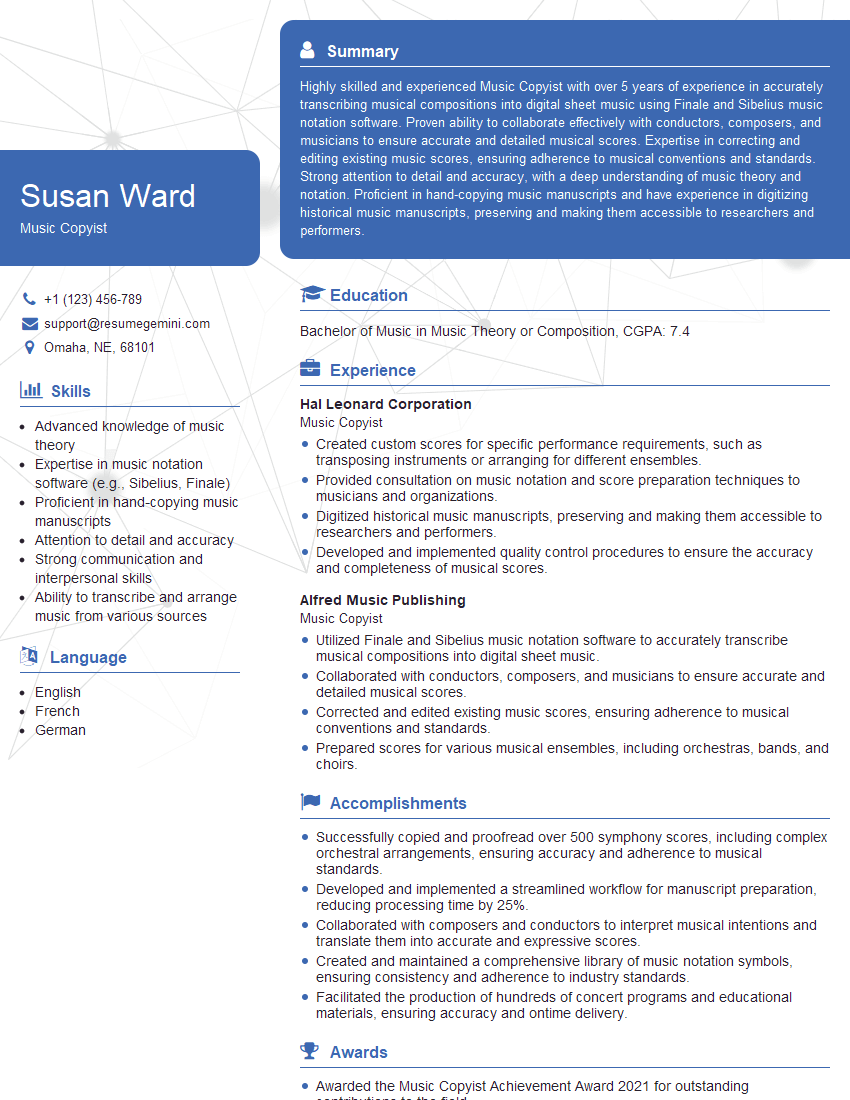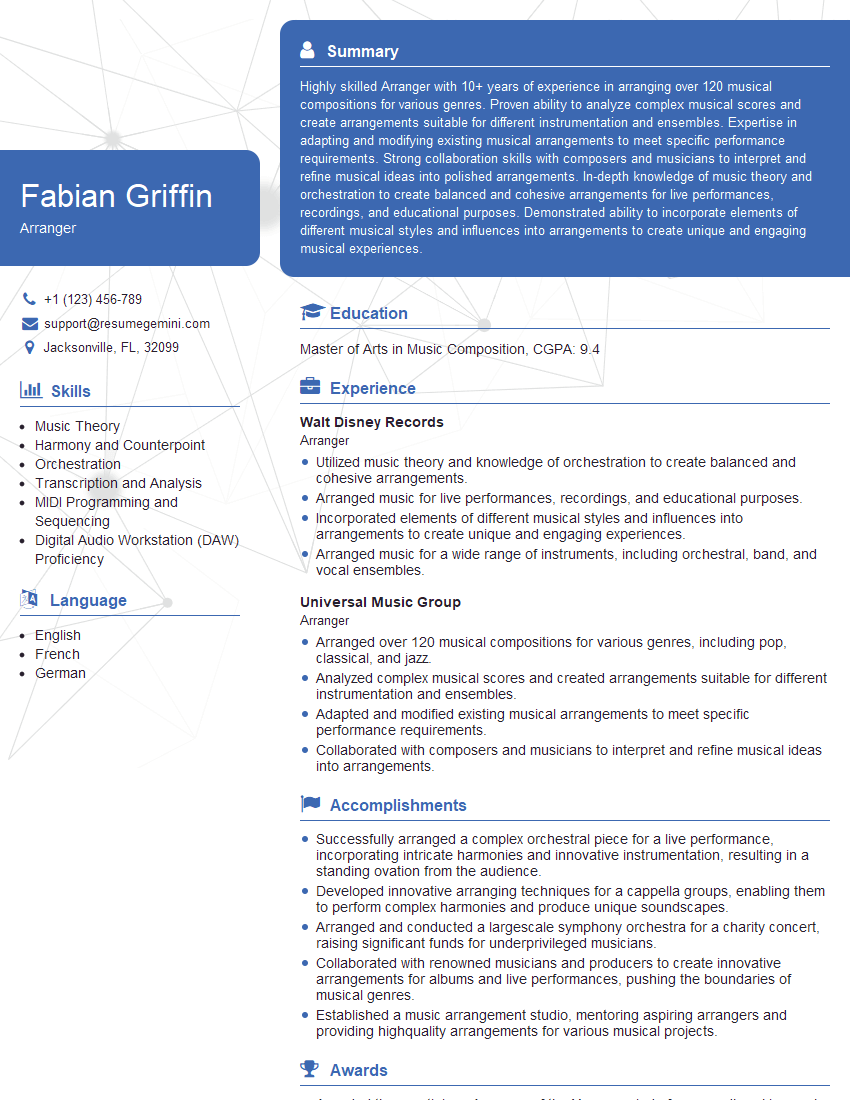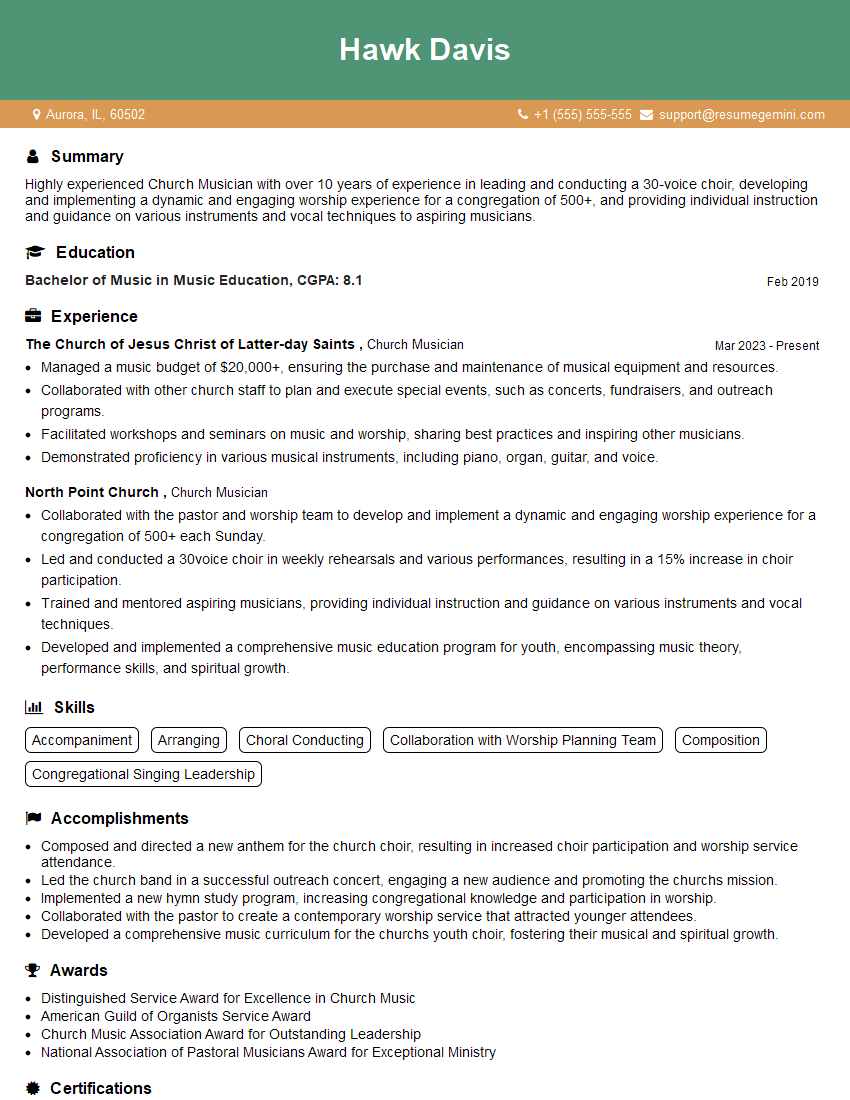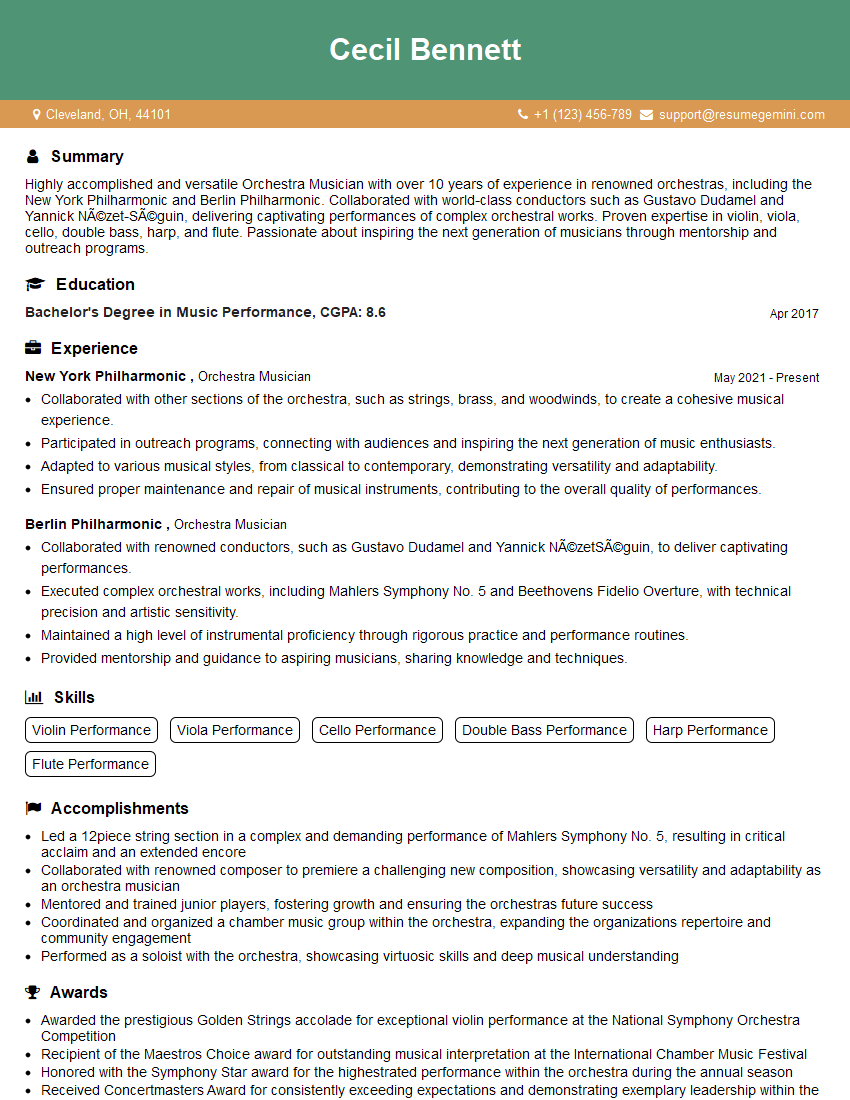The thought of an interview can be nerve-wracking, but the right preparation can make all the difference. Explore this comprehensive guide to Sight-Reading Proficiency interview questions and gain the confidence you need to showcase your abilities and secure the role.
Questions Asked in Sight-Reading Proficiency Interview
Q 1. Describe your approach to sight-reading unfamiliar musical notation.
My approach to sight-reading unfamiliar musical notation involves a systematic process that prioritizes understanding the overall structure before diving into the details. I begin by quickly scanning the piece to get a sense of its key, time signature, and overall character – is it a fast-paced sonata or a slow, melancholic ballad? This initial overview helps me establish a mental framework.
Next, I focus on the melodic contour, identifying the main phrases and their direction. I pay attention to leaps and stepwise motion to anticipate the musical flow. Then, I tackle the rhythmic aspect, breaking down complex rhythmic patterns into smaller, more manageable chunks. Finally, I work my way through the piece section by section, focusing on accuracy and gradually increasing speed as I become more comfortable with the material. Think of it like reading a book; you skim the chapters first to get the plot before immersing yourself in each paragraph.
For instance, if I encounter a piece in a minor key with many chromatic passing tones, I’ll first identify the overall tonality to understand the harmonic context before meticulously analyzing the nuances of the chromaticism.
Q 2. How do you handle complex rhythmic patterns during sight-reading?
Complex rhythmic patterns can seem daunting, but a strategic approach makes them manageable. I break down these patterns into smaller, more easily recognizable rhythmic units. I often use sub-division techniques, mentally dividing complex beats into smaller increments (e.g., dividing a triplet into three 16th notes). This helps me internalize the rhythm before attempting to play it at tempo.
I also visualize the rhythm through body movements or tapping my foot to feel the pulse. Sometimes, I even silently count out the rhythm several times before playing to build a strong internal representation. For example, a complex hemiola (e.g., a 3 against 2 rhythmic feel) can be broken down by feeling the underlying duple meter while simultaneously tracking the triple rhythmic pattern superimposed over it. This requires practice and precision, but with consistent effort, it becomes second nature.
Q 3. Explain your strategy for managing unfamiliar key signatures and accidentals.
Managing unfamiliar key signatures and accidentals requires a strong understanding of music theory. I begin by identifying the key signature and immediately understand its tonal center and accidentals. I use this knowledge to interpret any additional accidentals (sharps or flats) in the context of the key. If the piece modulates (changes keys), I carefully track these changes and adjust my interpretation accordingly.
For instance, encountering a piece in Db major will immediately tell me that all the flats from the key signature are applied throughout the piece unless an accidental overrides this – that’s my compass for interpreting the rest of the music. If a sharp unexpectedly appears, I know it’s a passing tone, or part of a temporary modulation. Thinking of these accidentals as ‘exceptions’ to a rule makes them easier to interpret.
Q 4. What techniques do you use to maintain tempo and accuracy while sight-reading?
Maintaining tempo and accuracy while sight-reading requires a balance between careful execution and a relaxed approach. It’s a skill developed over time, but key is consistent practice. Before playing, I take a moment to breathe deeply and mentally prepare myself to read and interpret the piece at a steady pace. I set a metronome to a reasonable tempo that allows me to play accurately – it’s better to start slowly and gradually increase speed as accuracy improves. This builds confidence and reduces pressure.
I also focus on articulation. I pay close attention to note values, rests, and dynamic markings (like crescendo or diminuendo) to ensure consistent tempo. It’s like driving a car; you need to control the speed (tempo) and steering (accuracy) for a smooth ride.
Q 5. How do you identify and correct mistakes while sight-reading?
Identifying and correcting mistakes during sight-reading is a crucial aspect of the skill. I rely on my musical knowledge and intuition. If a passage doesn’t sound right, I stop and analyze the notation to pinpoint the error. This might involve rereading the score, focusing on the rhythm and the intervals, and comparing them to the surrounding context.
If a repeated mistake is made, I will slow down to understand why it’s happening, and practice this section separately to address any technique challenges or theoretical misunderstandings. It’s a self-correcting process, and over time, one improves their ability to predict and anticipate these moments more effectively.
Q 6. Discuss your approach to sight-reading different musical styles (e.g., Baroque, Classical, Romantic).
Sight-reading different musical styles requires adaptability. My approach varies depending on the era and style. For example, Baroque music often features complex counterpoint and ornamentation. So I spend more time understanding the harmonic relationships between the different voices. Classical music is generally more homophonic (melody with accompaniment) and more easily predictable, requiring a focus on phrasing and dynamics. Romantic music is expressive and might involve wider melodic leaps and more harmonic changes; thus, a careful attention to the emotional arc is crucial. I apply this same principle to other styles like Jazz, focusing on the characteristic rhythmic and harmonic elements of each.
Essentially, I adapt my approach to match the particular musical language. The key is to study the stylistic features of each era and to internalize the ways composers of these periods typically express themselves through their use of harmony, rhythm, and melody.
Q 7. Describe your experience sight-reading from a lead sheet.
Sight-reading from a lead sheet requires a different set of skills. Unlike a full score, a lead sheet provides only the melody, chord symbols, and basic rhythm. I have to be able to improvise a suitable accompaniment based on the given chord progression. This requires a good understanding of harmony, improvisation techniques, and an ability to create a cohesive musical texture.
My approach involves first understanding the chord progression and its harmonic function. Then, I create a bass line to support the harmony, and finally I add rhythmic and melodic variations to create an engaging musical experience. A good sight-reader needs to be a good improviser here, as well. It’s akin to being given a sketch and being able to flesh it out into a full painting.
Q 8. How do you handle sight-reading with imperfect or incomplete notation?
Sight-reading imperfect notation requires a flexible and adaptable approach. It’s not about perfectly replicating the written score, but intelligently interpreting it to create a musical performance.
My strategy involves:
- Identifying the missing elements: I first pinpoint what’s missing – are there rhythmic values, notes, or articulation markings absent? This informs my approach to filling the gaps.
- Contextual Inference: I rely heavily on musical context. The surrounding notes, the key signature, and the overall style strongly suggest likely missing elements. For instance, if a melodic line jumps unexpectedly, the missing note might be a passing tone.
- Logical Completion: I fill in missing information logically, considering typical musical phrasing and voice leading. If a chord is incomplete, I complete it based on the surrounding harmony.
- Creative Interpretation: With significant gaps, I adopt a more interpretive approach, aiming for a musically coherent result even if it deviates slightly from a hypothetical complete score. This is particularly important in improvisational or historically informed performance practice.
For example, if a measure is missing a few rhythmic values, but the overall meter is clear, I’ll infer the missing rhythms based on the surrounding context and phrasing. If a few notes are missing in a melody, I might use my knowledge of typical melodic contours and voice leading to guess the missing notes.
Q 9. What is your approach to sight-reading ensemble music?
Sight-reading ensemble music demands a heightened level of awareness and coordination. It’s less about individual brilliance and more about effective collaboration.
My approach includes:
- Pre-reading: Before playing, I quickly scan the entire piece to understand its form, texture, and overall character. This gives me an overview of the musical landscape.
- Careful Part Study: I thoroughly examine my own part, identifying challenging passages or tricky rhythmic patterns. This allows me to preemptively address potential problems.
- Active Listening: During the performance, I listen intently to the other players. This allows me to stay in sync with the ensemble and adjust my tempo and dynamics as needed. It’s like a musical conversation.
- Flexibility and Adaptability: I remain flexible, ready to adjust my interpretation based on the group’s sound and the nuances brought by others. This allows for a unified musical result despite individual differences in interpretation.
- Clear Communication: Before the performance, if there are opportunities, I discuss potential challenges with my ensemble mates so that we can be prepared and support each other.
Imagine sight-reading a quartet – I’d focus on my individual part, but remain intensely aware of the overall harmonic context, ensuring my line fits smoothly with the others. Active listening is paramount for a successful ensemble performance.
Q 10. Explain your process for identifying harmonic progressions during sight-reading.
Identifying harmonic progressions during sight-reading is a crucial skill for any musician. It helps understand the underlying structure and emotional direction of the music. My process is systematic:
- Recognize Chord Voicings: I start by recognizing the individual chords, focusing on the root, third, and fifth. I might mentally label them (e.g., I-IV-V-I in C major).
- Understand Function: I consider each chord’s harmonic function (tonic, dominant, subdominant, etc.) within the key. This helps me understand its role in the progression.
- Identify Cadences: I listen for characteristic cadences (authentic, half, plagal) which often mark the end of phrases or sections.
- Look for Patterns: I recognize common harmonic patterns like ii-V-I progressions or circle-of-fifths movements. This provides a framework for understanding the overall harmonic structure.
- Consider Context: The musical context (genre, period, style) significantly informs my interpretation. A common progression in one style might be unconventional in another.
For instance, while sight-reading, if I encounter a series of chords like Cmaj7 – Fmaj7 – G7 – Cmaj7, I quickly recognize the common I-IV-V-I progression in C major.
Q 11. How do you determine the best articulation and phrasing during sight-reading?
Determining articulation and phrasing in sight-reading requires a blend of technical skill and musical sensitivity. I approach this in two stages:
- Initial Interpretation: First, I focus on understanding the composer’s intentions based on the notation. This includes considering note values, dynamics, and any explicit articulation markings (e.g., legato, staccato).
- Refined Interpretation: As I begin to play, I actively listen and adjust my articulation and phrasing to create a coherent musical narrative. This might involve subtle adjustments to the tempo, dynamics, and articulation to shape the phrases effectively. This is where musical instinct comes in.
An example would be a phrase marked ‘legato’. While I begin with a legato interpretation, I might find subtle variations in tempo or dynamics that enhance the natural flow of the phrase, while maintaining the core legato style.
Q 12. How does your sight-reading approach adapt to different instrumentations or vocal ranges?
My sight-reading approach adapts readily to different instrumentations and vocal ranges. The key is adaptability and understanding the unique characteristics of each instrument or voice type.
For example:
- Instrumentation: When sight-reading for a string quartet versus a brass quintet, I adjust my approach to account for the differing timbral qualities, ranges, and technical capabilities of each instrument group. A passage that works well for strings might sound awkward for brass, and vice versa.
- Vocal Ranges: When dealing with vocal music, I pay close attention to tessitura (the comfortable range of the voice) to avoid awkward leaps or notes that might be uncomfortable for the singer. I consider the specific characteristics of each vocal part (soprano, alto, tenor, bass).
- Transposition: If necessary, I’m able to quickly transpose music in my head or mentally visualize it in a different key to better suit the range of the performing forces.
Essentially, my approach involves a constant mental translation—imagining how the music will sound on the specific instruments or voices at hand, adapting my interpretation to maximize the impact and effectiveness of the performance.
Q 13. Describe a challenging sight-reading experience and how you overcame it.
One of the most challenging sight-reading experiences involved a complex contemporary piece for piano trio with numerous irregular meters and abrupt changes in texture. The score was densely notated, with little space for breathing.
My approach to overcoming this challenge involved:
- Section-by-Section Mastery: Instead of trying to grasp the entire piece at once, I broke it into smaller, manageable sections. This allowed me to focus on specific rhythmic and harmonic challenges without feeling overwhelmed.
- Detailed Analysis: I spent extra time analyzing the score before playing, identifying potential pitfalls and developing strategies for tackling them. This included marking important rhythmic cues and harmonic changes.
- Repetition and Practice: After initial attempts, I focused on repeating and practicing the challenging sections, gradually improving my accuracy and fluency. This gradual approach builds confidence and skill.
- Collaboration: I actively sought feedback from my fellow trio players. Their perspectives helped me identify areas for improvement and gain a better understanding of the overall musical context.
While I didn’t achieve perfection on the first attempt, this systematic approach allowed me to overcome the initial hurdle and deliver a satisfactory performance.
Q 14. What strategies do you use to improve your sight-reading skills?
Improving sight-reading skills requires consistent and dedicated practice. My strategies include:
- Regular Practice: I dedicate a portion of every practice session specifically to sight-reading, varying the style, complexity, and instrumentation of the pieces I choose.
- Gradual Progression: I gradually increase the difficulty of the pieces I sight-read. Starting with easier pieces builds confidence, while gradually challenging myself allows me to grow.
- Diverse Repertoire: I sight-read from a wide range of styles and periods, exposing myself to various musical languages, harmonic progressions, and rhythmic patterns.
- Focus on Weaknesses: I identify my areas of weakness (e.g., complex rhythms, unfamiliar harmonies) and focus on improving them through targeted exercises and practice.
- Record and Analyze: Recording myself sight-reading allows me to identify areas needing improvement. Analysis helps to develop targeted practice strategies.
- Use of Technology: Software and apps designed for sight-reading practice can offer a wide range of exercises and feedback to assist with development. This allows for more structured and focused practicing.
The key is consistent effort and focused attention, treating sight-reading practice as an essential element of overall musical development.
Q 15. How familiar are you with different types of musical notation?
My familiarity with musical notation extends beyond the basics. I’m proficient in reading standard Western notation, including treble and bass clefs, various time signatures (including complex ones like 7/8 and 5/4), key signatures (major and minor), and various rhythmic notations. I can also confidently interpret different types of articulation markings (staccato, legato, etc.), dynamic markings (piano, forte, crescendo, diminuendo), and ornamentation (trills, mordents, turns).
Beyond this, I have experience with less common notations such as figured bass (a shorthand for harmonic realization), tablature (particularly for guitar and lute), and even some historical notations. Understanding these diverse systems allows me to approach any score with confidence and flexibility.
- Standard Notation: This forms the foundation of my sight-reading abilities, encompassing all aspects of melodic and rhythmic structure.
- Figured Bass: This requires a strong understanding of harmony and counterpoint, which enhances my overall musical comprehension and improvisational skills.
- Tablature: Provides valuable insight into how music is physically played on specific instruments, impacting my interpretation and phrasing choices.
Career Expert Tips:
- Ace those interviews! Prepare effectively by reviewing the Top 50 Most Common Interview Questions on ResumeGemini.
- Navigate your job search with confidence! Explore a wide range of Career Tips on ResumeGemini. Learn about common challenges and recommendations to overcome them.
- Craft the perfect resume! Master the Art of Resume Writing with ResumeGemini’s guide. Showcase your unique qualifications and achievements effectively.
- Don’t miss out on holiday savings! Build your dream resume with ResumeGemini’s ATS optimized templates.
Q 16. Explain the importance of rhythmic accuracy in sight-reading.
Rhythmic accuracy is paramount in sight-reading; it’s the backbone of musical structure. Without precise rhythm, the music collapses—the phrasing becomes unclear, the melodic contour loses definition, and the overall meaning gets distorted. Think of it like building a house: if the foundation (rhythm) is shaky, the whole structure will crumble.
Maintaining rhythmic accuracy requires careful attention to the time signature, note values, rests, and any rhythmic markings like triplets or dotted notes. Regular practice with rhythmic exercises, including those with syncopation and irregular groupings, strengthens this crucial skill. Internalizing the pulse and feeling the subdivision of the beat are key to rhythmic precision. A single missed beat or note value can disrupt the overall musical flow, making the performance less satisfying for both the performer and the listener.
Q 17. How do you manage the balance between accuracy and expressiveness while sight-reading?
Balancing accuracy and expressiveness in sight-reading is a delicate art. Accuracy provides the solid base, while expressiveness adds the soul. One cannot exist fully without the other. Focusing solely on accuracy leads to a robotic performance, while excessive expressiveness without proper technical foundation results in a messy and imprecise rendition.
My approach involves a phased strategy. Initially, I prioritize accurate note-reading and rhythmic execution, establishing a secure foundation. Once comfortable with the technical aspects, I gradually incorporate phrasing, dynamics, and articulation to shape the musical narrative and convey emotions. This iterative process allows me to integrate both accuracy and expressiveness organically. Think of it like a sculptor: first, you create the accurate form, then you add the details and shading to convey life and emotion.
Q 18. Discuss the role of context and musical analysis in effective sight-reading.
Context and musical analysis are crucial for effective sight-reading, going far beyond simply decoding notes on a page. They transform note clusters into a meaningful musical experience. Understanding the style, period, and composer provides crucial insight into the intended interpretation. For instance, a baroque piece requires a different approach than a romantic one.
My process involves quickly analyzing the piece’s overall structure: identifying the key, time signature, melodic and harmonic progressions, and formal elements (like themes, variations, or cadences). This contextual understanding helps anticipate musical phrases, inflections, and potential challenges. For example, recognizing a deceptive cadence prepares me for a harmonic surprise and allows for a smoother transition. Without this analytical approach, sight-reading remains a mere technical exercise, devoid of musical depth.
Q 19. How do you prepare for a sight-reading audition?
Preparing for a sight-reading audition involves more than just playing through pieces beforehand. I focus on sharpening my fundamental skills. This includes consistent practice of rhythmic exercises, scales, arpeggios, and chord progressions in various keys and time signatures. I also dedicate time to reviewing different styles and composers, familiarizing myself with their characteristic traits and common harmonic patterns.
Furthermore, I ensure my instrument is in optimal condition and that I’m physically and mentally prepared. This includes sufficient rest and a calm, focused mindset. The goal is not just to play the piece accurately, but to demonstrate the ability to quickly process and effectively translate the written music into a musical performance. It’s also important to be prepared to handle unexpected challenges, like unusual key signatures or complex rhythmic patterns.
Q 20. What are your preferred methods for practicing sight-reading?
My sight-reading practice is multifaceted. I utilize a variety of methods, including:
- Working with graded sight-reading books: These provide a structured approach, gradually increasing difficulty.
- Utilizing online sight-reading resources: These often offer a vast selection of pieces in different styles and levels of difficulty.
- Playing excerpts from unfamiliar scores: This enhances my adaptability and ability to handle different styles and challenges.
- Focusing on specific aspects, such as rhythm or articulation: This targeted practice helps to pinpoint and address weaknesses.
- Regularly recording and analyzing my performances: This helps identify areas for improvement and track progress.
The key is consistent, regular practice, even if it’s just for a short period each day.
Q 21. How do you maintain musicality while sight-reading quickly?
Maintaining musicality while sight-reading quickly is about efficiency, not speed. It’s a balance between quick comprehension and thoughtful execution. This hinges on strong fundamental skills and a deep understanding of music theory. Pre-emptive analysis is key. Before I start playing, I try to quickly assess the overall structure, harmony, and phrasing.
While sight-reading, I focus on the larger musical phrases and shape them expressively, rather than getting bogged down in individual notes. I also pay attention to the dynamics and articulation markings to guide my interpretation. Think of it like driving a car: you need to glance at the map (analysis) and then focus on the road (performance), smoothly adjusting your speed and direction (musical expression) based on the terrain (the music).
Q 22. Describe your experience with sight-reading in various performance settings.
My experience with sight-reading spans various performance settings, from solo recitals and orchestral performances to chamber music ensembles and accompanying singers. In solo recitals, sight-reading new pieces requires immediate interpretation and expressive delivery, demanding a high level of technical skill and musicality. Orchestral settings demand a precise understanding of the score’s context, reacting instantaneously to the ensemble while maintaining individual accuracy. Chamber music involves collaborative sight-reading, requiring adaptability and quick communication with fellow musicians. Accompanying singers necessitates close attention to vocal phrasing and dynamics, demanding responsiveness and a strong understanding of musical expression. Each setting presents unique challenges, forcing me to adapt my approach while maintaining a high standard of performance.
For example, in a recent orchestral performance, I had to sight-read a new movement that included unexpectedly complex rhythmic passages. My prior experience helped me quickly identify the rhythmic patterns, and my understanding of the musical context allowed me to integrate seamlessly into the performance.
Q 23. How would you assess someone else’s sight-reading proficiency?
Assessing someone’s sight-reading proficiency involves a multi-faceted approach. I’d start by observing their approach to a new piece of music. Do they scan the piece efficiently for key signatures, time signatures, and overall structure? Do they recognize common musical patterns? Next, I’d evaluate their technical accuracy while playing. Are they playing the right notes, rhythms, and articulations? I also look for their expression, phrasing, and ability to navigate unexpected changes in tempo or dynamics. Finally, I consider their overall musicality and ability to communicate the music effectively. A structured test, with pieces of varying difficulty, would provide quantitative data to support the qualitative observation.
For instance, I might use a graded series of excerpts, progressing from simple melodies to more complex harmonic and rhythmic structures. This allows me to identify strengths and weaknesses and to pinpoint areas that require further development.
Q 24. What are some common pitfalls to avoid during sight-reading?
Common pitfalls in sight-reading often stem from a lack of preparation or poor reading strategies. One frequent mistake is focusing solely on individual notes rather than understanding the overall musical context. This leads to a choppy, unmusical performance. Another is neglecting to scan the piece beforehand, leading to surprises mid-performance. Poor rhythmic accuracy, stemming from failing to establish a steady pulse, is another frequent issue. Finally, neglecting dynamic and expressive markings can result in a bland and lifeless performance. Overly slow tempos, driven by a fear of making mistakes, can also hinder a sight-reading performance.
To avoid these pitfalls, I recommend practicing regular sight-reading exercises, focusing on understanding the harmonic and structural aspects of a piece before playing, and practicing with a metronome to improve rhythmic accuracy. Regularly sight-reading pieces slightly beyond one’s comfort zone can effectively expand one’s skills.
Q 25. Explain the relationship between sight-reading and music theory.
Sight-reading and music theory are inextricably linked. A strong foundation in music theory provides the framework for understanding the notation and interpreting the music accurately. Understanding key signatures, time signatures, chord progressions, and melodic intervals dramatically enhances one’s ability to anticipate and decode musical information quickly. For example, recognizing a dominant seventh chord typically suggests an impending resolution to the tonic. Knowing this theoretical framework allows a sight-reader to anticipate the direction of the music and play more smoothly.
Think of music theory as the roadmap for understanding the landscape of a score. The more detailed and accurate your map, the easier it is to navigate the musical terrain with confidence.
Q 26. How do you incorporate memorization techniques with sight-reading?
While sight-reading emphasizes immediate interpretation, incorporating memorization techniques can enhance performance quality. I don’t advocate for memorizing the entire piece beforehand, as this defeats the purpose of sight-reading. However, taking time to memorize short, crucial sections – like tricky rhythmic passages or complex harmonic changes – can boost confidence and improve fluency. This strategic memorization allows me to focus on the musical expression and interpretation of the sections that are less familiar, freeing up mental resources that would otherwise be devoted to deciphering the notes.
For instance, if a piece contains a particularly challenging passage, I might spend a few minutes memorizing that specific section before attempting to sight-read the entire piece. This targeted memorization technique allows me to overcome technical hurdles without compromising the spontaneity of sight-reading.
Q 27. Describe your strategies for handling unexpected changes in tempo or dynamics while sight-reading.
Unexpected changes in tempo or dynamics while sight-reading require adaptability and flexibility. My approach involves anticipating potential changes by scanning the score for dynamic markings and tempo indications beforehand. When a change occurs, I adjust my playing accordingly, prioritizing musical expression over rigid adherence to the original plan. This involves careful attention to phrasing and articulation to ensure a smooth transition. Focusing on the musical context helps maintain a cohesive interpretation even with unexpected shifts.
Imagine a piece that suddenly shifts from a slow, legato passage to a fast, staccato section. Rather than being thrown off, I would use my understanding of the music’s structure to prepare for such a change, allowing for a seamless transition between the two contrasting styles.
Q 28. How does your experience with different instruments inform your sight-reading abilities?
My experience with various instruments significantly informs my sight-reading abilities. Playing multiple instruments expands my understanding of musical notation, harmonic structures, and rhythmic complexities. For example, experience with piano develops a strong understanding of harmonic progressions and voicings, while playing wind instruments hones aural awareness and improves rhythmic precision. The transferable skills gained from one instrument enhance proficiency on others. The cross-training strengthens one’s overall musical literacy and interpretive abilities. This breadth of experience allows me to approach sight-reading with a wider perspective and deeper musical understanding.
My experience playing both piano and clarinet has helped me understand the different challenges each instrument presents. The piano’s polyphonic nature necessitates a different approach to reading compared to the clarinet’s melodic focus, but my experience with both instruments allows me to seamlessly adapt to either.
Key Topics to Learn for Sight-Reading Proficiency Interview
- Rhythm and Meter: Understanding complex time signatures, rhythmic notation, and syncopation. Practical application: Accurately interpreting and performing rhythms at varied tempos.
- Key Signatures and Scales: Identifying major and minor keys, understanding enharmonic equivalents, and applying knowledge of scales to sight-reading unfamiliar melodies.
- Interval Recognition: Quickly identifying intervals (seconds, thirds, fourths, etc.) both melodically and harmonically. Practical application: Understanding melodic leaps and harmonic progressions.
- Chord Recognition and Analysis: Identifying triads, seventh chords, and inversions. Practical application: Predicting harmonic direction and understanding the underlying harmony of a piece.
- Transposition: Accurately transposing melodies and harmonies to different keys. Practical application: Demonstrating adaptability and understanding of musical theory.
- Musical Style and Expression: Understanding stylistic nuances and applying appropriate phrasing, articulation, and dynamics while sight-reading. Practical application: Communicating musical intention effectively.
- Improvisation (if applicable): Creating melodic and harmonic variations based on a given harmonic progression. This is applicable for certain sight-reading positions.
- Problem-Solving Techniques: Developing strategies for tackling challenging passages, such as unfamiliar chord progressions or complex rhythmic patterns.
Next Steps
Mastering sight-reading proficiency is crucial for career advancement in music. It demonstrates a strong foundation in music theory and practical musicianship, opening doors to a wider range of opportunities. To maximize your job prospects, it’s essential to create a resume that effectively showcases your skills and experience to Applicant Tracking Systems (ATS). ResumeGemini is a trusted resource that can help you build a professional, ATS-friendly resume designed to highlight your unique qualifications. Examples of resumes tailored to Sight-Reading Proficiency are available to guide you through the process.
Explore more articles
Users Rating of Our Blogs
Share Your Experience
We value your feedback! Please rate our content and share your thoughts (optional).
What Readers Say About Our Blog
good
